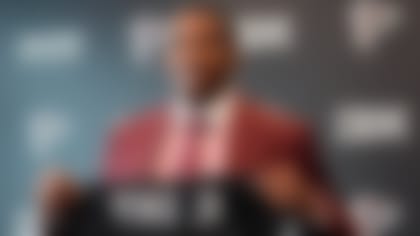What happened to Todd Gurley?
A year ago at this time, one could have made a case that he was the best player from the 2015 NFL draft class. Now it's debatable whether he's even one of his draft's top three running backs.
With all the focus lately on 2017's "can't-miss" running backs, I couldn't stop thinking about how quickly our assumptions about college prospects and pros transform. Yet, often those views don't change quickly enough, which is how the Browns were able to get a first-round pick from the Colts in exchange for former No. 3 overall pick Trent Richardson after Cleveland knew he was a bust.
It wouldn't be easy to top the 2015 crop of runners for depth and potential. Gurley was supposed to be the centerpiece. Instead, David Johnson -- the seventh back taken (86th overall) -- is the player with the Hall of Fame start to his career. Melvin Gordon and Jay Ajayi have already rewritten early expectations as pros, while an explosive second tier of runners like Tevin Coleman, Duke Johnson and Thomas Rawls is gaining a foothold.
I went back to watch Game Pass footage of this entire special group of runners to see how they all have evolved and where they fit in today, arranging the backs into the tiers you see below:
1) David Johnson, Arizona Cardinals
Originally drafted: Round 3, No. 86 overall.
Johnson put an exclamation point on his MVP-caliber campaign on Christmas Eve in Seattle, when he racked up 95 rushing yards and three touchdowns (plus another 41 receiving yards) against one of the league's best run defenses, long after Johnson's body should have buckled under the weight of carrying the Cardinals' season.
It's bizarre to think back to the draft profiles and scouts who questioned Johnson's toughness and power, saying he played running back like a receiver. In the final 20 minutes at Seattle, Johnson touched the ball 13 times for 99 yards and two scores to key an Arizona victory. He did it mostly with power, fighting for extra yards, excelling at resetting and finding a new hole after breaking a tackle. Johnson had 73 touches just against the Seahawks last season, a snapshot of a year in which Johnson answered any questions about his ability to be a workhorse.
What makes Johnson transcendent, however, is how he closed the Seahawks out with two catches. The kill shot came on a go-route where he lined up wide, beating safety Kam Chancellor before coming back to the football like a seasoned wide receiver. Perhaps those scouts now see that playing running back like a receiver is a good idea.
What is Johnson's ceiling?: It's unfair to put outsized expectations on Johnson after one complete season as a starter, but it's also unfair to have to try to stop Johnson's diverse skill set. It's as if the football gods gave Emmitt Smith the receiving ability of Marshall Faulk. Johnson sees the ball on third-and-short and is often the primary receiver on third-and-long. He can run inside but also innately feels when a defender is near, jump-cutting away before the pressure gets there. Opponents rarely hit him squarely.
Johnson and Le'Veon Bell are the only two players in NFL history to record a season with 1,200-plus rushing yards and 800-plus receiving yards by Year 2. Johnson has a chance to explore uncharted territory, and I'll be there for every second of it. Coach Bruce Arians and Around The NFL mensch Chris Wesseling were ahead of the curve, saying early that Johnson could be an all-time great.
Quality starters
2) Melvin Gordon, Los Angeles Chargers
Originally drafted: Round 1, No. 15 overall.
First impressions can contaminate the consensus regarding a player long after that player transforms. Gordon's first impression was full of false steps. There is a fine line between patient and tentative for pro running backs, and it took a season for Gordon to explode over that line.
Through Week 13 of the 2016 campaign -- Gordon's last full game of the season, thanks to hip and knee injuries -- only two running backs had more than his 1,411 yards from scrimmage: Ezekiel Elliott (1,607) and David Johnson (1,709). Football Outsiders' numbers knock Gordon for being inefficient, but that doesn't take into account the Chargers' awful run-blocking. Gordon was hit in the backfield or swarmed by multiple defenders just as much as Todd Gurley was in 2016, but Gordon still created seven runs over 20 yards compared to Gurley's two. (Pro Football Focus ranked the Chargers' run-blocking No. 27 in the NFL, one spot behind the Rams.)
Gordon reminds me of a lesser, bigger version of Jamaal Charles. Both players are incredible at making cuts while moving forward. They both set up blockers well, waiting for holes to develop before picking their lane. Gordon doesn't explode quite like Charles, but both runners force bad angles from defenders because they go from zero to fast like few others. Gordon runs with an athletic arrogance that jumps off the screen. To use Cam Newton's words, Gordon was "dripping goo" on his runs as the season wore on. (Am I doing this right?) The numbers support it: Gordon got better in the second half of games and the second half of the season.
Why Gordon is ranked ahead of Gurley: I didn't want to be a prisoner to 2016 alone when coming up with these rankings. But it's just as misleading to only focus on Gurley's incredible first month in the NFL. If Gordon's 2016 season had been his first impression with NFL fans, he'd rightly be seen as a complete top-10 running back for years to come. He's a terrific receiver and better in space than Gurley. That's where today's game is played. Gordon might not have the upside of Gurley, but I have a handle on what Gordon is at the pro level after two seasons. Gurley, on the other hand ...
3) Todd Gurley, Los Angeles Rams
*Originally drafted: Round 1, No. 10 overall. *
The need to explain away Gurley's disastrous second season is mystifying. The short version goes like this: The Rams' offense was run by paste-eating middle schoolers, and Gurley had no chance. No further analysis necessary.
Gurley's 278 carries tell a different story. At least four to five times each game, Gurley had daylight to work with. He often ran up the backs of his offensive linemen or was arm-tackled. If Gurley's game isn't about making defenders miss, then he'll need to run through defenders more often. He simply didn't show the same burst, second effort or power that he did in his Offensive Rookie of the Year campaign. The Rams coaching staff noticed, often taking him out of the game in key situations or failing to give him the ball late with the lead.
For a window into Gurley's season, let's travel to Seattle last December. On fourth-and-1 inside the Seahawks' 10-yard line early in the game, Gurley got the ball on a pitch to the left. He had his choice of multiple lanes and elected to take on Seahawks linebacker Bobby Wagner, only needing to gain a few inches with a full head of steam. Wagner stood him up cold and eventually pushed Gurley backward with some help. It was an example of Wagner's greatness, but Gurley also should have made the play.
Of course the season wasn't all Gurley's fault. The criticism of the Rams' passing game and offensive line was accurate. Still, that's not the point. Gurley was supposed to be a transcendent talent, the kind of player who should make his teammates look better. Try to imagine Adrian Peterson or Barry Sanders or even Corey Dillon carrying the ball 278 times with a 3.2 yards-per-carry average and only two runs over 20 yards, even with lousy offenses around them. Something was wrong.
Trying to explain Gurley's down season: This is the part where it's really tempting to play amateur psychologist and guess what was in Gurley's mind or heart last season, to interpret those shakes of the head or the lackluster runs in garbage time. I went into this exercise hoping to see something positive from Gurley, but aside from his occasional light feet and graceful glide, it just wasn't there. At his best out of the I-formation, Gurley was The Franchise, until quarterback Jared Goff -- who is more comfortable out of the shotgun -- came along as the first overall pick in the 2016 NFL Draft. How to split the difference is up to new coach Sean McVay.
McVay should help considerably by modernizing the offense. Gurley could bounce back on the strength of big plays as a top running back, and no one would be surprised. He showed that much talent as a rookie. This ranking is reflective of Gurley righting himself as a solid starter. But Gurley has to show himself to be a different player this year, to recognize that his sophomore slump was about more than his teammates. Otherwise, it will be time to trust what Gurley shows on Sundays over those scouting reports from the 2015 draft season.
4) Jay Ajayi, Miami Dolphins
Originally drafted: Round 5, No. 149 overall.
They don't have an NFL Scouting Combine test for running hard. Perhaps that's how teams let Ajayi slip to the fifth round despite his being a favorite of the draftnik community. Ajayi's runs look like car crashes, yet he always attacks the next snap like he's fresh off the lot.
Watching Ajayi contributed to my struggle to rank Gurley for this exercise. Miami's run-blocking was ranked behind the Rams' group by PFF (30th overall), yet Ajayi ran in every score and situation with such velocity. In some games, the eight-man fronts swallowed him. But more often, he ran through his obstacles.
The data supports the film. PFF ranked Ajayi No. 1 last season by a wide margin in their elusive rating, on the strength of forcing 58 missed tackles, 11 more than the next-closest back. Ajayi is a load to take down, but he can get to the edge on the way to a big play. Only Ezekiel Elliott and LeSean McCoy had more runs over 20 yards. Ajayi's second 200-yard game against Buffalo (and third of the season) in Week 16 -- despite his suffering a shoulder injury -- was one of the gutsiest performances of 2016. On one play, he literally carried linebacker Lorenzo Alexander like he was going against a middle-schooler. Ajayi got Rex Ryan fired.
So why isn't he ranked higher?: I want to see Ajayi's follow-up season. His running style could invite injuries and be tough to duplicate year after year. More importantly, he's not yet an asset on passing downs, coming in dead last in yards-per-route among running backs who played at least 25 percent of their team's snaps, according to PFF. That slightly lowers Ajayi's ceiling, but he could make this ranking look as silly as a 175-pound cornerback trying to tackle him. After making his first Pro Bowl, anything less than a long run as a quality starter would be a disappointment.
Role players-plus
5) Duke Johnson, Cleveland Browns
Originally drafted: Round 3, No. 77 overall.
Put Johnson on the Patriots or Falcons, and he'd be a star. Put him on the Browns, and he's a role player who most fans haven't been plugged in on since before the 2015 NFL Draft. However, only two running backs (David Johnson and Theo Riddick) have more receiving yards since 2015. Duke Johnson has quickness that you can't teach. On one play against the Chargers, he caused an injury because two defenders ran into each other after tackling the space where Johnson used to be.
Johnson is ranked so high here because every team in the NFL would love to have him, and he's just getting started. He's been incredibly efficient on a poor offense, finishing No. 2 in yards-per-route among running backs with at least 50 targets, according to PFF. Johnson won't make a living running inside, but only bad teams focus on what their players can't do. Johnson fits perfectly in today's NFL as a "space player" who will probably be catching 50 passes a year for another decade. Teams can win with guys like Johnson.
6) Tevin Coleman, Atlanta Falcons
Originally drafted: Round 3, No. 73 overall.
Coleman leads the league in forcing inside linebackers to mutter "Oh, s---" under their breath. When the Falcons isolate Coleman one-on-one against the wrong player, the play is over before it starts. The most famous example came when Coleman beat Rob Ninkovich for a touchdown in Super Bowl LI, but Coleman is the rare NFL player who routinely makes opponents, even defensive backs, look like they are moving in slow motion.
Coleman is not your typical shifty third-down back. He's a decisive cutback runner who knows when to square his shoulders and take the 7-yard gain in front of him. He has a nose for the end zone (14 TDs in 16 games last year, including the playoffs) and can briefly take over a game like he did during a third-quarter drive in the Divisional Round against Seattle.
So why isn't he ranked higher?: Coleman wouldn't fit in most systems. He was only on the field for 34 percent of the Falcons' regular-season snaps in 2016, a number that decreased in the playoffs. That's primarily because Coleman plays alongside one of the league's 10 best backs in Devonta Freeman, but it's worth wondering if Coleman could hold up to 300 carries with his frame and running style. The Falcons smartly use him as a turbo-charged 1B.
It's a shame that Coleman's breakout season ended on such a tragic, if forgotten note. On second-and-2 with nine minutes left and a 28-12 lead in Super Bowl LI, Coleman was injured on a 1-yard gain. Freeman replaced him and missed a block on the next play, leading to a Matt Ryan fumble and the greatest comeback in Super Bowl history.
7) Thomas Rawls, Seattle Seahawks
Originally drafted: Undrafted.
Don't blame Rawls for feeling raw. He returned from a broken leg last season in time to run for 161 yards in a playoff win, then watched as the Seahawks made replacing him an offseason priority.
Rawls was a revelation as an undrafted rookie, but his coaches believed he put too much pressure on himself to find the perfect hole in his second season. That was understandable. He was running behind a dreadful offensive line and suffered devastating injuries (a broken ankle in 2015 and the leg in 2016), only 19 regular-season carries apart. When the Seahawks transitioned from focusing on their outside-zone plays to inside runs, Rawls again ran with an abandon that few backs can match.
The most like Marshawn: The irony of Seattle potentially replacing Rawls is that he's more like former Seahawk Marshawn Lynch than any other NFL running back. Not a consistent factor on passing downs, Rawls has an incredible combination of lateral quickness and power. He routinely breaks the first tackle and has a natural downhill style. He has three performances of over 160 yards in only 16 starts (including the postseason). Give him quality blocking, and that's what he can do. Seahawks coach Pete Carroll, a huge fan of Rawls, said it best:
"He makes somebody miss to find somebody to hit."
Despite Eddie Lacy's presence with the Seahawks, my money would be on Rawls leading the team in rushing this season, like he did in 2015.
8) Ameer Abdullah, Detroit Lions
Originally drafted: Round 2, No. 54 overall.
It was awesome, then it was over. In one run, Abdullah made two Titans defenders bear-hug air, tore through a tackle, and then tore a ligamentin his foot. The play cemented Abdullah's reputation as a player who can't hold up physically, though it's too early to know if that reputation is truly accurate. Abdullah played all 16 games in his rookie season. More importantly, his game-and-a-half in 2016 were eye-opening. He put up 120 yards on only 17 touches in Week 1. Give him space, and he's going to fashion a clown suit for someone. When asked to run inside, Abdullah fights through tackles and falls forward.
Don't give up on Abdullah as a potential difference-maker. The Lions haven't -- SEE: Zero running backs taken in the draft -- and fantasy owners shouldn't, either.
Lot to prove
9) Matt Jones, Washington Redskins
Originally drafted: Round 3, No. 95 overall.
"Where is Matt Jones?" has officially replaced "Who is Mike Jones?" as one of America's greatest mysteries.
After breaking 100 yards twice in a three-game stretch last October, Jones fumbled against the Lionsin Week 7 and was banished for the rest of the season in favor of "Fat Rob" Kelley. Jones deserves another chance.
There aren't many 235-pound backs with the wiggle Jones possesses. He finishes runs. In 2016, he averaged 4.6 yards per carry and was on pace for over 1,000 yards when he was benched for the rest of the season. His fumbling is a problem, and it's true that Jones almost seeks out contact too much, but the guy was also plain unlucky. Six of his eight career fumbles were recovered by the opposition. Would he have been benched if Washington had recovered more? Of his three fumbles in 2016, one came off a funky handoff and another was the result of a direct helmet shot on the ball.
Melvin Gordon looked like a bust to some after one season, and Jones now looks like a bust after two. I'm still holding out hope for a Matt Jones-aissance, because the talent is there.
10) T.J. Yeldon, Jacksonville Jaguars
*Originally drafted: Round 2, No. 36 overall. *
Sometimes "playing it safe" can be the riskiest move a general manager can make. Jags GM David Caldwell drafted Yeldon with the notion that the Alabama product was proficient at everything, even if he wasn't great in any one area. Yeldon was supposed to be the type of back you could turn a running game over to without a lot of drama. That proved true, but in the worst way possible.
Yeldon is not a player I recommend watching late at night. He gets what's blocked and not much more. His lauded receiving skills are fine, but not special enough to make him a logical third-down role player. A victim of his draft slot, no one would complain about Yeldon if he had been drafted in the fourth round. Taking him No. 36 overall, ahead of six of the players ranked above, has proven to be a fiasco for Caldwell, one he first tried to cover up by signing Chris Ivory and then all but erased by drafting Leonard Fournette No. 4 overall.
Other 2015 favorites
Zach Zenner, Detroit Lions: Undrafted out of South Dakota State, Zenner is on his way to a productive career as a role player that should last longer than those of many of the players drafted ahead of him.
Jeremy Langford, Chicago Bears: A productive rookie season (816 yards from scrimmage) gave way to a spot on the bench behind Jordan Howard in Year 2. Langford (drafted in Round 4, No. 106 overall) is a good example of the difference between playing speed and timed speed. He was the fastest back in his class at the NFL Scouting Combine, but it doesn't show up on the field. I undertook this exercise hoping to learn new things, but Langford's tape was defined by its complete lack of surprise.
Karlos Williams, free agent: Remember him? After scoring nine touchdowns as a rookie with the Bills (drafted in Round 5, No. 155 overall), Williams has been suspended twice for substance abuse, released twice and chided for his weight by Rex Ryan, of all people. He figures to get one more chance in the NFL.
Buck Allen, Baltimore Ravens: A healthy scratch in Baltimore after a productive rookie season, Allen (drafted in Round 4, No. 125 overall) will be fighting for his roster spot following Danny Woodhead's signing.
Follow Gregg Rosenthal on Twitter @greggrosenthal.












